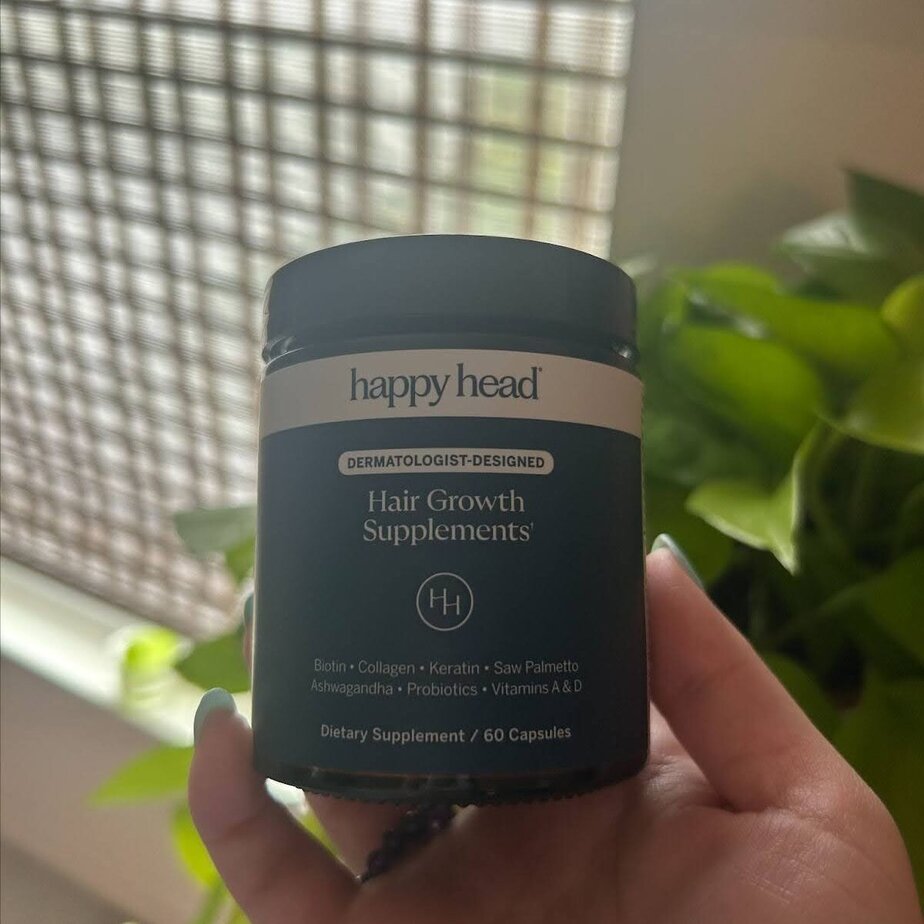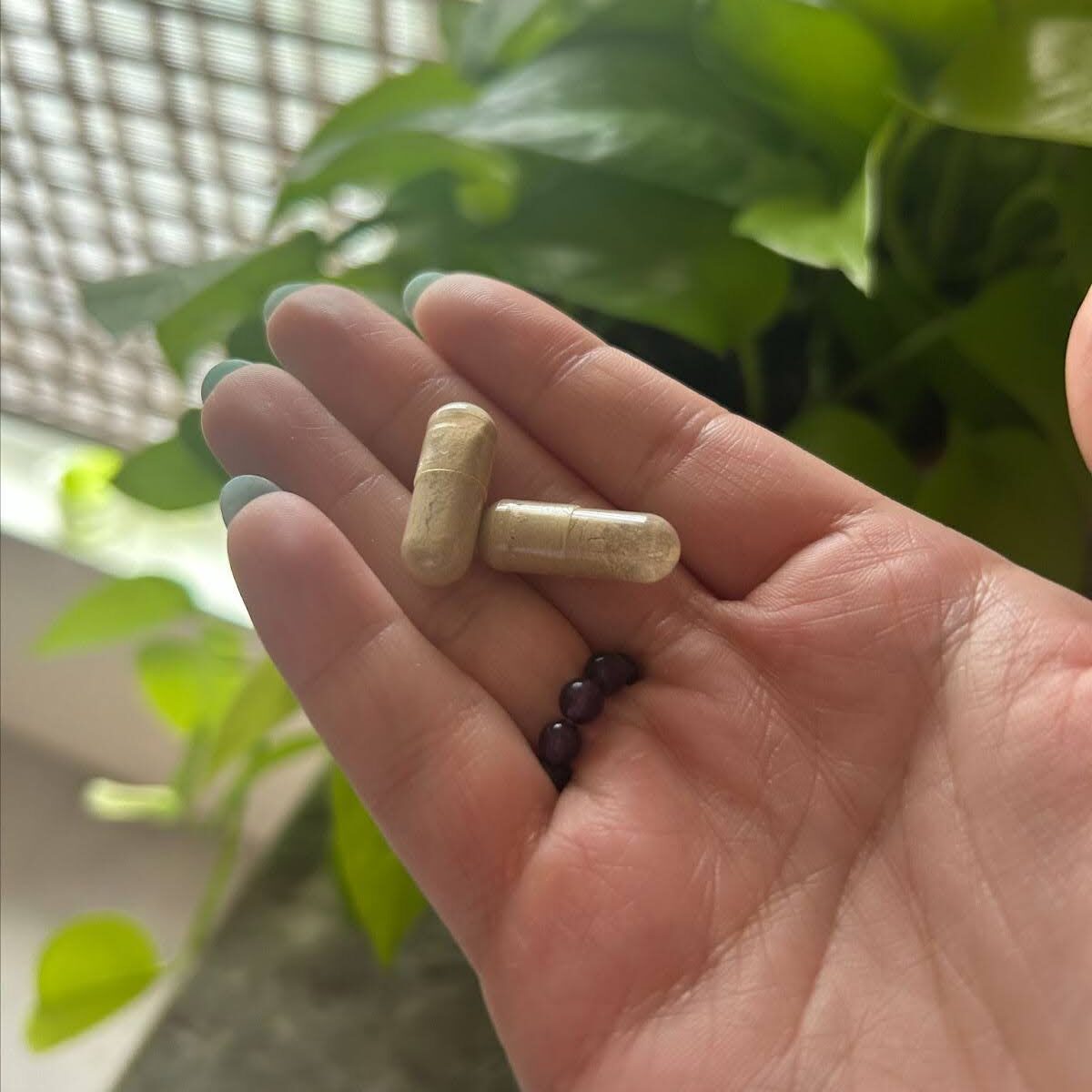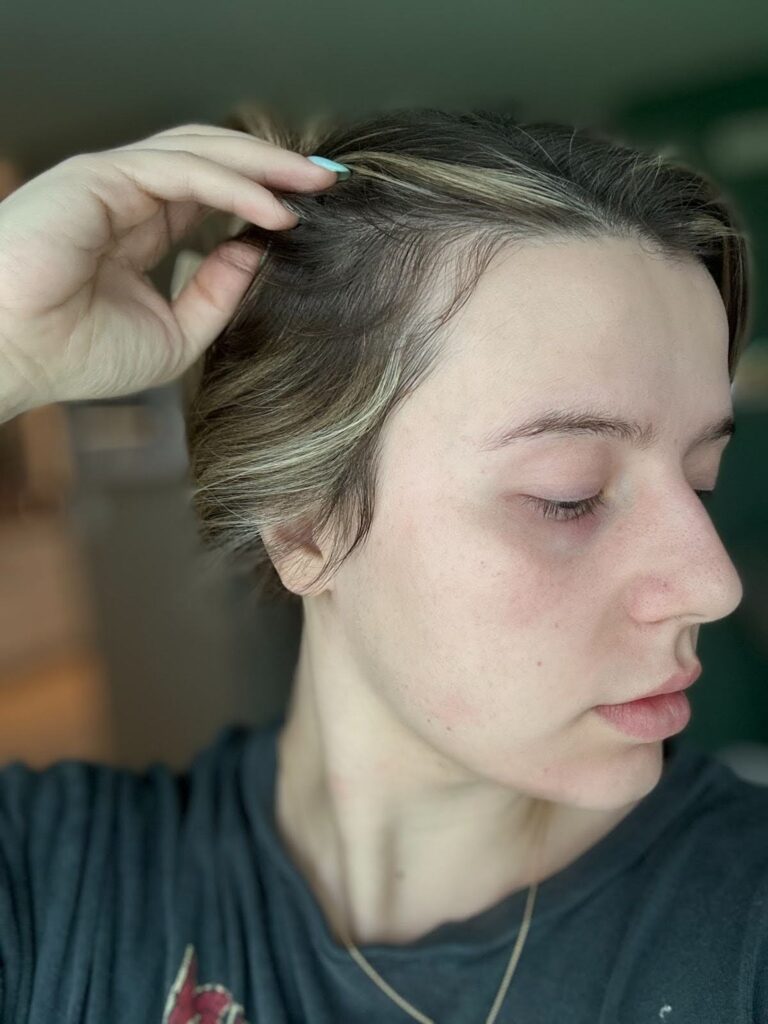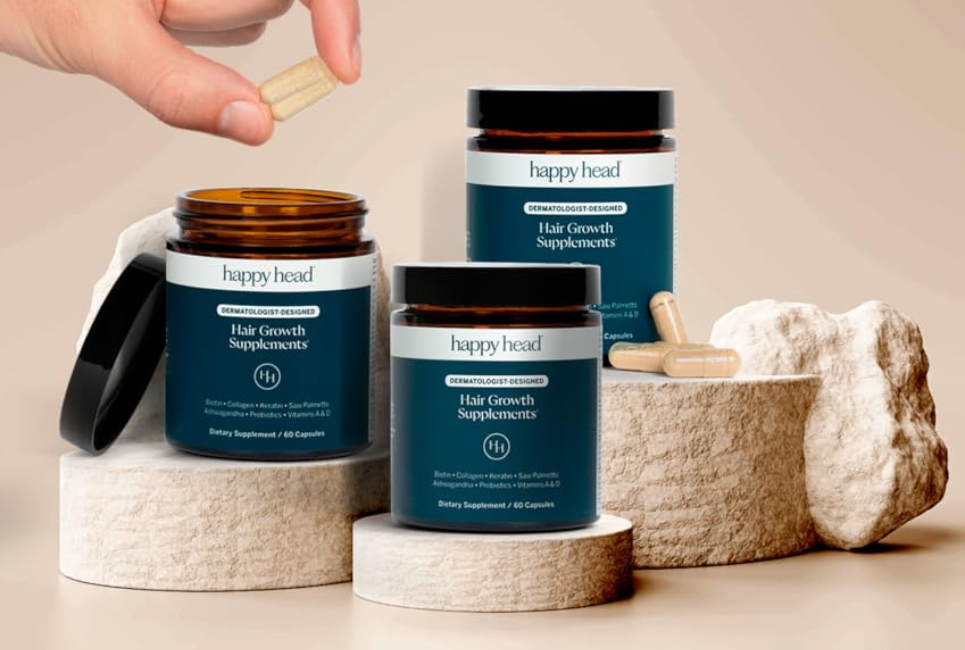Introduction: One Supplement, Many Variables
Hair thinning isn’t always about age, stress, or styling habits. For some of us, it’s deeply tied to hormonal health—and in my case, PCOS (Polycystic Ovary Syndrome) plays a starring role. If you’re unfamiliar, PCOS is a complex endocrine disorder that affects everything from menstrual cycles to metabolism—and unfortunately, hair growth is one of the most visible symptoms.
Like many people with PCOS, I live in a frustrating in-between: losing hair in places I wish I had more, especially around the temples and crown, while simultaneously battling unwanted coarse regrowth in areas like my chin and neck. It’s a confidence struggle that’s both emotionally and physically exhausting.
Because my hair thinning is hormonally driven, I’ve always approached supplements with a healthy dose of skepticism—and, if I’m honest, low expectations. I didn’t believe a few capsules could undo years of DHT sensitivity and insulin resistance. Still, I was open to anything that might help, as long as it didn’t pretend to be a miracle fix.
Why I Tried Happy Head—Even With Low Expectations

Happy Head supplements are marketed as a physician-formulated, dermatologist-backed solution for men and women experiencing thinning, breakage, or sluggish growth. With a clean, modern brand aesthetic and a formula that boasts both DHT-blocking ingredients and nutritional support, it piqued my interest as something more than just another biotin-and-collagen cash grab.
But here’s the thing: I’m not only taking Happy Head. Over the last few months, I’ve also made broader changes in my routine to support both my hormones and my hair:
- I’ve increased my daily protein intake (aiming for 150g/day)
- I switched to a salon-quality shampoo
- I use a scalp massager during showers to stimulate blood flow
- I apply a targeted scalp serum 2–3 times per week
- And I’ve continued managing my PCOS through diet (specified macro nutrients), sleep (9 hours a night), and supplements (as recommended by my doctors).
This review reflects all of that—not to dismiss the supplement’s potential, but to honestly contextualize the results I’ve seen so far. After all, no supplement exists in a vacuum, and I believe readers deserve a complete picture when evaluating any wellness product.
My Expectations Going In
What I hoped for wasn’t dramatic regrowth or a magic cure—but maybe, just maybe, a boost. A little more fullness around my temples. A little less daily shedding. Some subtle movement in the right direction that might complement the bigger-picture work I’m doing for my overall health.

I’ve taken Happy Head every day for the past three weeks, exactly as directed. No skipped doses, no doubling up. Just consistency. I also made sure to take before-and-after photos in the same lighting and angle to track progress as objectively as possible—because sometimes our eyes can play tricks on us, especially when we want to see a change.
Now, three weeks isn’t enough time to see full regrowth or major density changes. That’s just not how hair works. But when I compared my day one photo to the one I took at the end of week three, I noticed something subtle but real: in the area by my right temple—where there was a pretty obvious gap in the first photo—there’s now a bit more coverage. It’s not fully filled in, but there’s a soft shadow of new growth, almost like the early fuzz you get after a fresh wax starts growing back in (except, you know, where I want it this time).
It’s the kind of change I might’ve dismissed if I hadn’t documented it, but side by side, the difference is there. I’m not talking about dramatic results, but something that makes me feel encouraged enough to keep going.
What makes it more meaningful is knowing that this supplement isn’t acting alone in my routine. I’ve been eating more protein, using quality scalp care, and addressing my PCOS in other ways—but Happy Head seems to be playing its part in the overall picture. I didn’t expect it to work miracles, and it hasn’t—but it does feel like it’s giving my scalp the nutritional push it needed to maybe start responding again.
Of course, I’m still early in the process. Hair regrowth takes time, consistency, and a whole lot of patience. But for anyone wondering if three weeks of Happy Head is enough to show even the slightest sign of progress—my answer, surprisingly, is yes. Not life-changing yet, but promising.
Below are the comparison photos—unedited, unfiltered, and taken under the same lighting—so you can judge for yourself. Look closely at the temple region; that’s where I’ve seen the most change, and where I’ll be tracking progress most closely as I continue.
Inside the Capsule: What’s Actually in Happy Head?


Before I ever swallow a supplement, I read the label. And I have to say, Happy Head’s formula pleasantly surprised me. Unlike so many generic hair supplements that throw in 10,000 mcg of biotin and call it a day, this one offers a balanced, research-informed blend of vitamins, minerals, and plant-based compounds that target hair health from multiple angles.
Here’s a closer look at the ingredients and what current data says about each one:
1. Saw Palmetto (15 mg)
When I began exploring supplements to support hair growth, saw palmetto (Serenoa repens) consistently appeared in discussions about natural remedies for androgenetic alopecia and hormone-related hair thinning. This botanical extract, derived from the berries of a small palm native to the southeastern United States, is renowned for its potential to inhibit the enzyme 5-alpha-reductase. This enzyme converts testosterone into dihydrotestosterone (DHT), a hormone implicated in shrinking hair follicles and shortening the hair growth cycle.
In the context of PCOS, where elevated androgen levels can exacerbate hair thinning, the DHT-blocking properties of saw palmetto are particularly relevant. By potentially reducing DHT levels, saw palmetto may help mitigate one of the hormonal drivers of hair loss.
A 2020 review published in Skin Appendage Disorders highlighted the efficacy of saw palmetto in improving hair quality and density. Participants using saw palmetto treatments experienced an average 60% improvement in overall hair quality and a 27% increase in total hair count. These findings suggest that saw palmetto can be a valuable component in a multifaceted approach to addressing hair thinning.
It’s important to note that saw palmetto is fat-soluble, meaning it’s best absorbed when taken with meals containing healthy fats, such as avocados or nuts. This enhances its bioavailability, ensuring that the body can effectively utilize its active compounds.
Incorporating saw palmetto into my regimen felt like a proactive step towards addressing the hormonal aspects of my hair thinning. While it’s not a standalone solution, its inclusion in the Happy Head supplement aligns with a holistic strategy aimed at supporting hair health from multiple angles.
2. Biotin (3,000 mcg)
Biotin is one of those ingredients you’ll see in nearly every hair supplement—and yes, it’s in Happy Head too. It’s included because it supports keratin production, the protein that gives structure to hair, skin, and nails.
Now, while biotin has a solid reputation in the beauty world, the actual science behind it is… mixed. A 2017 review in Skin Appendage Disorders found that biotin supplementation helped people who had underlying medical conditions or actual biotin deficiencies—but not so much for healthy individuals without one (Patel et al., 2017).
Because I have PCOS, a condition that can increase your body’s need for certain B vitamins, I didn’t mind seeing biotin in the formula. It’s water-soluble, meaning my body will excrete any excess, and it could offer support if I’m not getting enough through food.
Personally, I don’t think biotin alone made a dramatic difference in my hair growth—but as part of the full Happy Head blend, I appreciated having it in the mix. It feels more like a supportive nutrient than a star player.
3. Vitamin D3 (31.25 mcg)
As someone managing PCOS, I’m acutely aware of the importance of vitamin D—not just for bone health, but for its role in hormonal balance and hair growth. Vitamin D receptors are present in hair follicles, and deficiencies have been linked to various forms of hair loss, including telogen effluvium and androgenetic alopecia.
A 2013 study published in Skin Pharmacology and Physiology found that women experiencing hair loss had significantly lower levels of vitamin D compared to healthy controls. The researchers concluded that vitamin D deficiency could be a contributing factor in hair loss and suggested that supplementation might help normalize the hair growth cycle.
Given that vitamin D is fat-soluble, I made sure to take the supplement with meals containing healthy fats to enhance absorption. While I can’t attribute my hair improvements solely to this vitamin, ensuring adequate vitamin D levels felt like a proactive step in my hair care regimen.
4. Zinc (12.5 mg)

Zinc plays a crucial role in hair tissue growth and repair. Deficiencies in zinc have been associated with hair loss, and individuals with PCOS may be at a higher risk due to potential absorption issues. Although, I’m not sure I am deficient to begin with as I was not tested before taking the supplement.
A study published in Annals of Dermatology in 2013 examined the effects of zinc supplementation in patients with alopecia areata, an autoimmune form of hair loss. The study found that zinc supplementation led to significant improvements in hair regrowth among participants with low zinc levels.
Including zinc in the Happy Head supplement aligns with the goal of addressing potential nutritional deficiencies that could impact hair health.
5. Bovine Collagen (200 mg)
Collagen is often marketed as a miracle for hair, skin, and nails—but the truth is a bit more nuanced. Bovine collagen provides amino acids like glycine and proline, which are building blocks for keratin, the protein that forms hair. That sounds promising—but does taking collagen orally actually translate into more hair growth?
The research is still emerging. A 2022 review in Marine Drugs noted that collagen peptides may improve skin elasticity and hydration, but evidence for direct hair growth benefits remains limited unless you’re dealing with age-related collagen decline or poor dietary protein intake (Zague et al., 2022). Another small study published in Journal of Cosmetic Dermatology (2020) suggested a collagen supplement combined with other ingredients could improve hair volume and scalp coverage in women with self-perceived thinning hair—but it’s difficult to isolate collagen’s impact alone.
In short: Collagen may support hair structure indirectly, especially if your diet is low in protein or you’re not getting enough of the amino acids needed for keratin production. Since I’ve been boosting my protein intake during this time, it’s hard to know if the collagen specifically moved the needle—but I like that it’s there as part of a broader structural support system.
6. Ashwaganda Root Powder (125 mg)
This one felt much more relevant to me. Ashwagandha is an adaptogen, a class of herbs that help the body regulate stress hormones—specifically cortisol, which plays a major role in hair shedding. Stress (even low-grade, chronic stress) can trigger telogen effluvium, a type of hair loss where follicles prematurely enter the resting phase.
For those of us with PCOS, cortisol dysregulation is often tangled up with insulin resistance, inflammation, and elevated androgens—all of which impact hair growth. So the inclusion of ashwagandha in Happy Head felt particularly strategic.
Scientific research supports ashwagandha’s benefits when it comes to stress and hormone regulation. A randomized, double-blind, placebo-controlled study published in Cureus (2019) found that daily supplementation with 250 to 600 mg of ashwagandha significantly reduced stress levels, improved cortisol regulation, and enhanced overall well-being over an eight-week period.
While there’s no direct evidence that ashwagandha alone triggers hair regrowth, its impact on lowering stress hormones and inflammation helps create a much more favorable environment for hair to thrive—particularly for those of us navigating hormonal imbalances like PCOS.
That said, I did notice that Happy Head’s dose—125 mg per serving—is on the lower end. Given the more promising results seen in studies using at least 250 mg, I would have loved to see the dosage a bit higher to fully tap into its potential benefits.
The Ingredient Verdict
Happy Head doesn’t reinvent the wheel—but it puts together the right pieces in the right amounts, and that matters. Every ingredient in the formula is either:
- Clinically supported, or
- Structurally important
From a bioavailability perspective, it’s best taken with a meal that includes some healthy fat—especially because several key ingredients (vitamin D and saw palmetto) are fat-soluble and need that dietary fat to be properly absorbed.
While it’s challenging to isolate the effects of each ingredient, the combination of these nutrients in Happy Head provided a comprehensive approach to supporting hair health. For someone dealing with PCOS-related hair thinning, incorporating these supplements, alongside dietary and lifestyle modifications, felt like a step in the right direction. This type of supplement can be a valuable part of a broader toolkit. It’s not a cure, but it can be a support system—especially when you’re playing the long game, which hair regrowth always is.
If you’re considering trying Happy Head, I recommend consulting with a healthcare provider to ensure it’s appropriate for your individual needs, especially if you have underlying health conditions or are taking other medications.
- Rogaine vs. Happy Head: My 4-Month Hair Serum Results - November 4, 2025
- Why I Tried Happy Head Shampoo & Conditioner - October 9, 2025
- The Best Keeps Alternatives for Hair Loss - July 22, 2025

